How to Maintain Your Scooter: A Comprehensive Guide
Welcome to "How to Maintain Your Scooter: A Comprehensive Guide." This guide is your one-stop resource for ensuring the longevity and optimal performance of your scooter. As a scooter enthusiast and owner, I've come to understand the importance of regular maintenance.
Through this guide, I aim to share the wealth of knowledge and experience I've gathered over the years. My goal is to help you maintain your scooter effectively, ensuring it remains a reliable and enjoyable mode of transportation.

You'll find practical advice and insights that cater to both new scooter owners and seasoned riders. I'll walk you through the essential maintenance tasks, tips to prevent costly repairs, and best practices for keeping your scooter running smoothly.
Whether you use your scooter for daily commutes or leisure rides, maintaining it properly is crucial. So, let's dive in and explore the world of scooter maintenance together, ensuring your ride is always in top condition!
Understanding Your Scooter
As a scooter owner, it is important to understand the various components of your scooter and their functions. This knowledge will help you identify potential issues and address them in a timely manner. In this section, I will discuss all the components and functions of a scooter, as well as battery care and management.
Components and Functions
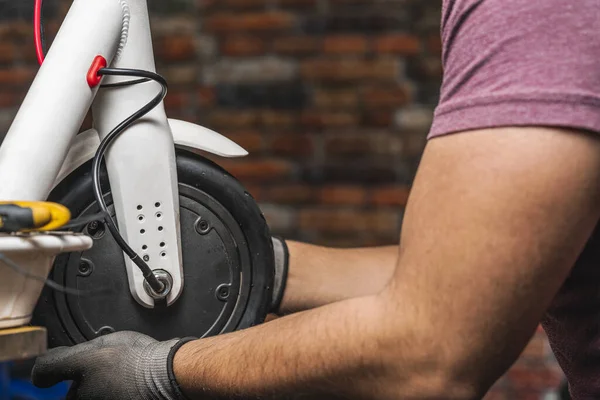
Understanding the key components of your scooter is essential for effective maintenance and safe riding. Here's a breakdown of the major parts and their roles:
Frame: The frame is the backbone of your scooter, providing structural support. It's crucial to inspect the frame regularly for any signs of damage, cracks, or rust, as these can compromise the scooter's integrity and safety.
Wheels: The wheels are critical for mobility and traction. Regular checks should include inspecting the tire condition, air pressure (for pneumatic tires), the integrity of the rims, and the condition of the air filters. Worn-out tires or damaged wheels can significantly affect performance and safety.
Brakes: Brakes are your primary safety feature, so they demand frequent attention. Check for wear on brake pads, ensure the brake mechanism is functioning smoothly, and look at brake discs for any signs of damage or unusual noise. Additionally, remember to inspect and maintain the brake fluid level and quality, as properly functioning brakes, including the brake fluid, are crucial for safe stopping and maneuverability.
Handlebars: Handlebars are your main control interface. They should be securely attached and correctly aligned. Regular checks should include ensuring all controls are easily reachable and functioning, and that grips are secure and in good condition.
Regular maintenance and prompt attention to any issues not only prolong the lifespan of your scooter but also ensure a safer and more enjoyable riding experience. Remember, the better you know and care for your scooter, the better mileage more reliable it will be.
Importance of Familiarizing Yourself with the User Manual
Understanding the user manual of your scooter is a crucial step in ensuring its proper maintenance and longevity. Far from being just a booklet to skim through, the user manual is a comprehensive guide containing specific instructions, information, and regulations tailored to your specific scooter model.
Each scooter model has its unique maintenance needs, and the manual outlines the specific intervals for routine checks, part replacements, and servicing. This is essential for keeping on top of maintenance requirements.
The manual offers tailored instructions that range from basic operations to troubleshooting. This helps ensure that you handle your scooter correctly, avoiding common mistakes that could lead to damage. Moreover, the warranty of your scooter often depends on following the manufacturer’s guidelines for use and maintenance, including changing the transmission oil. Familiarizing yourself with these guidelines is crucial to ensure you don't inadvertently void your scooter owners warranty.
Safety is paramount, and the manual includes critical information in this regard. Understanding and adhering to these safety guidelines can prevent accidents and ensure that your riding experience is both enjoyable and safe.
Additionally, by following the manufacturer's recommendations, you can maintain the optimal performance of your scooter. This includes advice on battery care, tire pressure gauge, and other key factors that influence performance.
Lastly, if your scooter allows for customization or requires periodic adjustments, the owner's manual provides necessary guidance to make these changes safely and effectively. In summary, the user manual is an invaluable resource for any scooter owner, providing essential information for the care and optimal use of the scooter.
Regular Maintenance Schedule
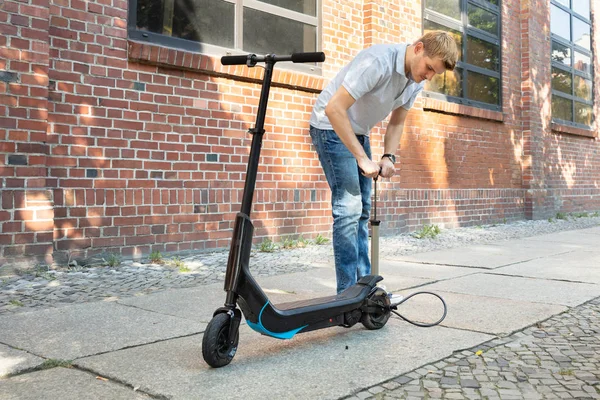
Maintaining your scooter is essential to keep it running smoothly and extending its lifespan. Here's a regular maintenance schedule that includes some valuable maintenance tips you can follow to keep your scooter in tip-top condition.
Daily and Weekly Check-Ups
Performing daily and weekly check-ups is crucial to ensure the safety and longevity of your scooter. Here are some tasks that you can do:
-
Check the pressure in the tires and make sure they are inflated to the recommended level to prevent tire wear. Under-inflated tires can lead to poor performance and reduce the battery life of your scooter.
-
Inspect the brakes and make sure they are functioning correctly. If you notice any unusual noises or difficulty in braking, it's time to replace the pads.
-
Clean the scooter using a damp cloth to remove any dirt or debris that may have accumulated on the surface. This will help prevent rust and corrosion.
Monthly Inspection Tasks
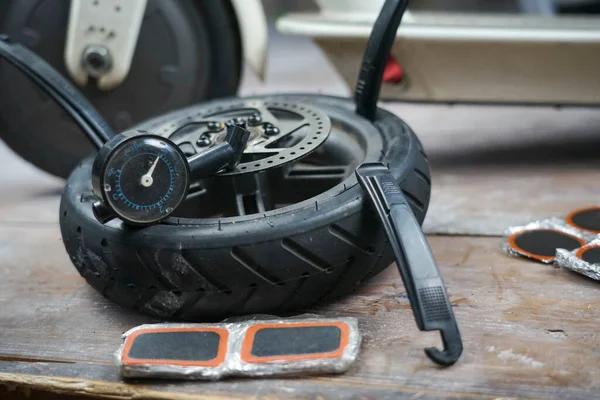
In addition to daily and weekly check-ups, it's important to perform monthly inspection tasks to keep your scooter in excellent condition. Here are some tasks that you can do:
-
Inspect the chain and sprocket for any signs of wear and tear. If you notice any damage, it's time to replace them.
-
Check the battery connections and make sure they are tight and secure. Loose connections can lead to poor performance and reduce the battery life of your scooter.
-
Lubricate the moving parts of your scooter to prevent rust and corrosion.
Quarterly and Annual Services
Performing quarterly and annual services is essential to keep your scooter running smoothly. Here are some tasks that you can do:
-
Replace the brake pads and tires if necessary.
-
Inspect the bearings and replace them if necessary.
-
Check the motor and controller for any signs of wear and tear. If you notice any damage, it's time to replace them.
By following this regular maintenance schedule, you can keep your scooter in excellent condition and enjoy a smooth and safe ride every time.
Cleaning and Storage
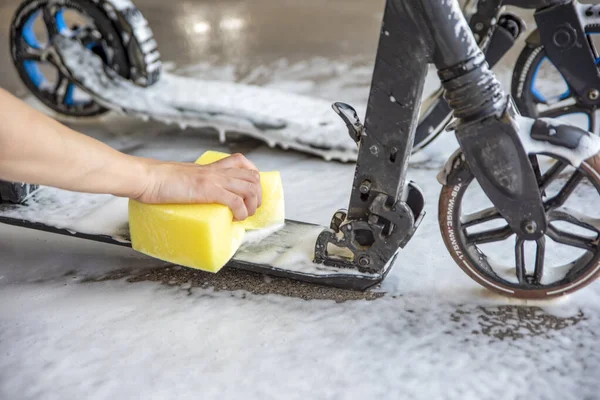
Proper Cleaning Techniques
Maintaining a clean scooter is essential for its longevity. Dirt, dust, and debris can cause damage to the scooter's components, especially if it is left on for a long time. Here are some proper cleaning techniques to keep your scooter in good shape:
-
Use a soft cloth or sponge to wipe down the scooter's frame, wheels, and deck. Avoid using abrasive materials that can scratch the surface.
-
Use a mild detergent or soap and warm water to clean the scooter.
-
Dry the scooter thoroughly with a clean cloth or towel. Ensure that no moisture is left behind before storing the scooter.
Optimal Storage Conditions
Proper storage conditions are crucial in maintaining the scooter's longevity. Here are some optimal storage conditions to keep your scooter in good shape:
-
Store the scooter in a dry and cool place. Direct sunlight and exposure to the elements can cause damage to the scooter's components.
-
Keep the scooter clean and dry before storing it. Removing dirt, dust, and debris helps prevent potential damage during storage.
-
Lubricate the moving parts of the scooter before storing it. This helps prevent rust and corrosion and ensures that the scooter is in excellent condition and ready to ride when you retrieve it.
By following these maintenance tips, proper cleaning techniques and optimal storage conditions, you can ensure that your scooter stays in great condition and is safe to ride.
Troubleshooting Common Issues
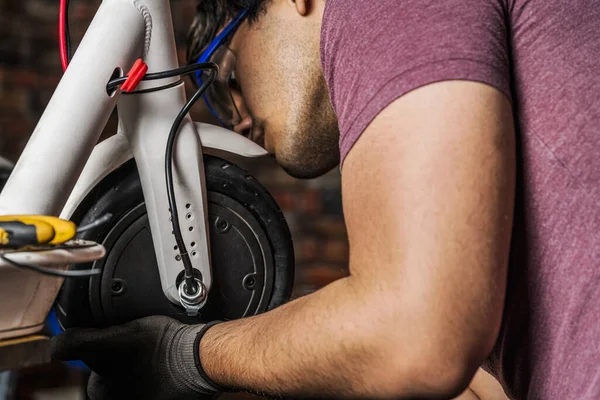
As with any vehicle, scooters can experience problems from time to time. Here are some common issues you may encounter while using your scooter, along with some tips for troubleshooting and fixing them.
Dealing with Flat Tires
One of the most common problems with scooters is getting a flat tire. To avoid this, it's important to regularly check the correct pressure in the tire and ensure that your tires are properly inflated to support your body weight. If you do get a flat tire, here are some steps you can take to fix it:
-
Remove the wheel from the scooter.
-
Remove the tire from the wheel.
-
Inspect the tire for punctures or other damage.
-
If the tire is damaged, replace it with a new one.
-
If the tire is not damaged, patch the puncture using a tire patch kit.
-
Reinstall the tire onto the wheel.
-
Reinstall the wheel onto the scooter.
Addressing Braking Problems
Another common problem with scooters is braking issues. If you're experiencing problems with your brakes, here are some steps you can take to fix them:
-
Check the brake pads to make sure they're not worn down.
-
Adjust the brake cable tension if necessary.
-
Check the brake lever to make sure it's not loose or damaged.
-
If the brake pads are worn down or the lever is damaged, replace them with new ones.
-
If the cable tension is too loose or too tight, adjust it accordingly.
Conclusion
Maintaining your scooter is an ongoing responsibility that directly impacts its performance, safety, and longevity. By adhering to a regular maintenance schedule, familiarizing yourself with the user manual, and understanding the functions of various components, you can ensure your scooter operates at its best.
Regular cleaning and proper storage are essential to protect it from the elements and prevent wear and tear. Keeping a close eye on tire pressure, brakes, air filters, and the battery, and addressing any issues promptly, including maintaining the correct air pressure in your scooter's tires, will not only extend the life of your scooter but also provide a safer, more enjoyable riding experience.
Remember, the key to successful scooter maintenance lies in a proactive approach. Whether it’s performing daily checks, monthly inspections, or attending to annual services, each step plays a crucial role in keeping your scooter in top condition, including the examination of electrical components if possible.
Equipping yourself with the knowledge and tools needed for basic repairs and maintenance empowers you to take charge of your scooter's health, saving you time and money in the long run. By following these guidelines, you can enjoy the freedom and fun of riding your scooter, confident in its reliability and safety.
Frequently Asked Questions
What routine maintenance tasks are essential for scooters?
As a scooter owner, to keep your scooter in optimal condition, you should regularly perform routine maintenance tasks. Unlike vehicles that need fuel consumption, scooters have different maintenance needs. These tasks include checking the tire pressure, cleaning the scooter regularly, inspecting the brakes and cables, and tightening any loose screws or bolts.
How often should I lubricate my scooter's moving parts?
The frequency of lubrication depends on how often you use the scooter and the manufacturer's recommendations. As a general rule, you should lubricate the moving parts of your scooter every three months or after every 500 miles. However, you should check the manufacturer or service call's instructions for specific recommendations.
What is the recommended procedure for tuning up a scooter?
A tune-up involves inspecting and adjusting the various components of your scooter to ensure that it is running smoothly. The recommended procedure for tuning up a scooter includes checking the brakes, cables, and chain tension, inspecting the bearings, and adjusting the tire pressure. You should also check the scooter's battery and charger to ensure that they are functioning correctly.
Can I perform scooter repairs at home, and what tools are required?
Some scooter repairs can be performed at home, while others require professional assistance. For minor repairs, you will need basic tools such as a wrench, screwdriver, and pliers. However, for more complex repairs, you may need specialized tools such as a multimeter or soldering iron.
What are the signs that my scooter's bearings need lubrication?
If you notice that your scooter is making unusual noises or has decreased performance, it may be a sign that the bearings need lubrication. You may also notice that the scooter is vibrating excessively or that the wheels are not spinning freely. In such cases, you should inspect the bearings and lubricate them if necessary.
What items should be included in a comprehensive scooter maintenance checklist?
A comprehensive scooter maintenance checklist should include tasks such as checking the tyre pressure, inspecting the brakes and cables, lubricating the bearings, and tightening any loose screws or bolts. You should also check the battery and charger to ensure that they are functioning correctly. Additionally, you should check the scooter's lights and reflectors and make any necessary adjustments.
